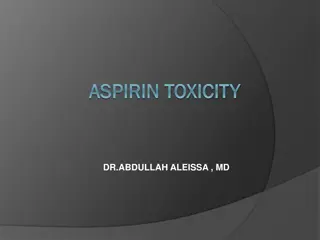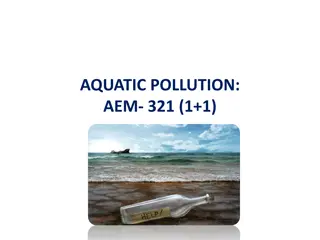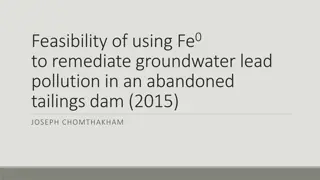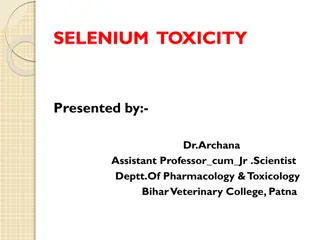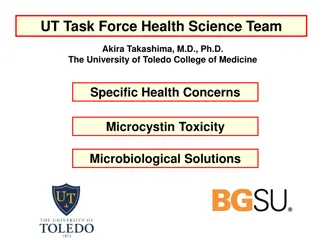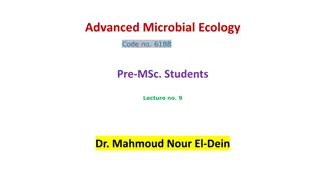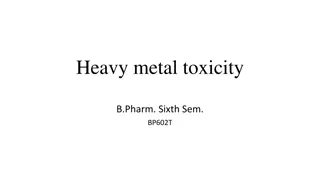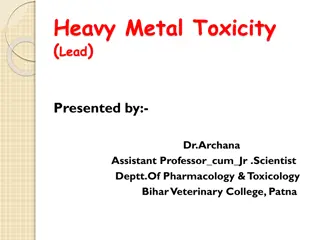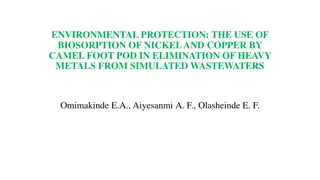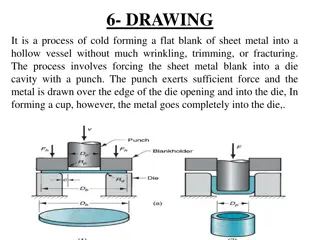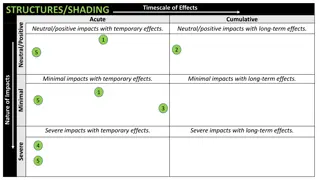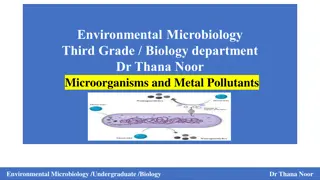Understanding Heavy Metal Toxicity: Impacts on Aquatic Life and Human Health
Heavy metal toxicity poses a significant threat to both aquatic ecosystems and human health, with various heavy metals accumulating in the environment and food chain. This overview highlights the adverse effects of heavy metals like copper, nickel, zinc, cobalt, and cadmium on physiological processes, leading to chronic diseases and degenerative conditions. The presence of these toxicants in industrial effluents further exacerbates the pollution of water bodies, affecting organisms and serving as biomarkers of environmental degradation.
Download Presentation

Please find below an Image/Link to download the presentation.
The content on the website is provided AS IS for your information and personal use only. It may not be sold, licensed, or shared on other websites without obtaining consent from the author. Download presentation by click this link. If you encounter any issues during the download, it is possible that the publisher has removed the file from their server.
E N D
Presentation Transcript
Dr. Alkesh I. Shah Dr. Alkesh I. Shah Associate Professor & Head Associate Professor & Head Zoology Department Zoology Department B. P. Baria Science Institute B. P. Baria Science Institute NAVSARI NAVSARI INDIA INDIA
HEAVY METAL IMPACT ON AQUATIC LIFE AND HUMAN HEALTH AN OVERVIEW April 7th 2017
Heavy metal toxicity - a major threat to life with several health risks. These have hardly any biological role to play in human body but cause malfunctioning of the body system. These may act as pseudo elements of the body, interfering with metabolic processes in body. They accumulate in the body causing chronic diseases. Metal toxicity depends on the route of absorption, absorbed dose, as well as duration of exposure.
Industrial effluents contain a variety of toxicants - salts of heavy metals, acids, organic matter, pesticides and even cyanides which deteriorate the physico-chemical characteristics of water. These pollutants build up in food chain and are responsible for adverse effects and even death of organisms in aquatic system. Fish serve as biomarkers of aquatic pollution as studies on the overall health are widely carried out to evaluate the physiological changes of aquatic ecosystems.
The most commonly found heavy metals in waste water include Copper, Nickel, Zinc, Cobalt and Cadmium; all of which are harmful to human health in particular and the environment in general. Heavy metal toxicity lower energy levels and damage functioning of organs like brain, lungs, kidney, liver, and alter blood composition. Long term exposure to high concentrations lead to gradual and progressive physical, muscular and neurological degenerative processes like Multiple sclerosis, Parkinson s, Alzheimer s and Muscular dystrophy and even Cancer.
There are 35 different metals of great concern because of risk to residential or occupational exposure, out of which 23 are heavy metals, namely: Antimony, Arsenic, Bismuth, Cadmium, Cerium, Chromium, Cobalt, Copper, Gallium, Gold, Iron, Lead, Manganese, Mercury, Nickel, Platinum, Silver, Tellurium, Thallium, Tin, Uranium, Vanadium and Zinc. These heavy metals are commonly found in the environment and diet. In small amounts they are essential for maintaining good health but in larger amounts they become toxic, and hence dangerous.
Fish is high in omega-3 fatty acid and protein, that the human body needs to stay healthy. However, potentially dangerous heavy metals are absorbed into body tissues of fish, then transferred to humans on consumption. Good quality of food for human can only be produced in an environment free from contamination and pollution. Fish are of great economic importance. They are adversely affected by various chemicals including heavy metals directly or indirectly. Several reports world-wide indicate the high mortality rate in juvenile fish as well as reduced breeding potential of adults on long term exposure to heavy metals.
The freshwater fish, Labeo rohita is of great commercial importance as it is most common fish widely consumed worldwide. Hence it is the best model to study the responses to heavy metal contaminations. Histopathological studies on fish are noteworthy and promising to study the structural organization and changes in the organs due to pollutants in the environment. These structural changes vary with: the body parts, nature of the pollutants, medium and duration of exposure. Water quality characteristics also influence and display the histopathological manifestations of toxic effects.
The structural changes in the organs at microscopic, cellular and organ level leads to alterations of the life-functions. Hence the main objective of this study is to provide an insight into the source of heavy metals and their harmful effects on environment and living organisms.
Methodology METHODOLOGY
Fingerlings of major carp Labeo rohita of both sexes are kept as stock in O2 saturated water at slightly alkaline pH. Fish food was fed twice a day. Fish are acclimatized in laboratory condition for 15 to 20 days. Fish were subjected to different concentration of salts of heavy metals in ppm. The salts used were ZnCl2, CdCl2, CuCl2, NiSO4, CoSO4.
Amino acids were separated from the fish tissues after 20 days. Qualitative and Quantitative analysis was carried out by Chromatographic Technique. Haematological studies of the Fingerlings was done by preparing blood smears to observe cellular alterations. Smears were stained with Leishmann's stain and observations were noted.
RESULT AND DISCUSSION
Effect of varying concentrations of heavy metal salts on normal blood cells of fish Labeo rohita exposed for 15, 30 and 45 days was studied. Following physiological changes in the fish were observed: Cell membrane gets wrinkled, damaged or totally destroyed. Nucleus may shift in position. Size of nucleus may either be reduced or enlarged. Nucleus may be totally distorted. Vacuolization and cell necrosis is observed inside the cell.
Result of physiological changes due to the effect of heavy metal on fish Labeo rohita: Optical density change of different amino acids subjected to various concentrations of Heavy metal salts in ppm was observed. In case of chlorides of copper, zinc, and cadmium; amino acids like Valine, Histidine, Proline, Glycine, Alanine and Methionine were seen to be declining. In case of Sulphate of Nickel and Cobalt, amino acids like Leucine, Proline, Glycine and Aspartic acid showed a tremendous decrease in amount. The results clearly indicate the decrease of protein content in fish and as well as all other aquatic animals.
Optical density change of different amino acids subjected to various concentration of Copper Chloride 0.04 0.035 0.03 0.025 0.02 0.015 0.01 0.005 0 3 ppm 3 ppm 3 ppm 3 ppm 3 ppm 3 ppm 2 ppm 2 ppm 2 ppm 2 ppm 2 ppm 2 ppm 1 ppm 1 ppm 1 ppm 1 ppm 1 ppm 1 ppm control control control control control control Histidine Proline Glycine Alanine Methionine Valine Exposure time ( Day ) 15th Exposure time ( Day ) 30th Exposure time ( Day ) 45th
Optical density change of different amino acids subjected to various concentration of Nickel Sulphate 0.07 0.06 0.05 0.04 0.03 0.02 0.01 0 40 ppm 40 ppm 40 ppm 40 ppm 70 ppm 70 ppm 70 ppm control control control control 55 ppm 55 ppm 55 ppm 55 ppm 70 ppm Glycine Aspartic Acid Proline Leucine Exposure time ( Day ) 15th Exposure time ( Day ) 45th Exposure time ( Day ) 30th
Optical density change of different amino acids subjected to various concentration of Zinc Chloride 0.045 0.04 0.035 0.03 0.025 0.02 0.015 0.01 0.005 0 40 ppm 40 ppm 40 ppm 40 ppm 40 ppm 40 ppm 60 ppm 60 ppm 60 ppm 60 ppm 60 ppm control control control control control control 50 ppm 50 ppm 50 ppm 50 ppm 50 ppm 50 ppm 60 ppm Proline Glycine Alanine Methionine Valine Histidine Exposure time ( Day ) 15th Exposure time ( Day ) 45th Exposure time ( Day ) 30th
Optical density change of different amino acids subjected to various concentration of Cobalt Sulphate 0.07 0.06 0.05 0.04 0.03 0.02 0.01 0 10 ppm 10 ppm 10 ppm 10 ppm 30 ppm 30 ppm 30 ppm 20 ppm 20 ppm 20 ppm 20 ppm 30 ppm control control control control Proline Glycine Aspartic acid Leucine Exposure time ( Day ) 15th Exposure time ( Day ) 30th Exposure time ( Day ) 45th
Optical density of different amino acids subjected to various concentration of Cadmium Chloride 0.04 0.035 0.03 0.025 0.02 0.015 0.01 0.005 0 5 ppm 5 ppm 5 ppm 5 ppm 5 ppm 5 ppm 15 ppm 15 ppm 15 ppm 15 ppm 10 ppm 10 ppm 10 ppm 10 ppm 10 ppm 10 ppm control control control control control control 15 ppm 15 ppm Histidine Proline Glycine Alanine Methionine Valine Exposure time ( Day ) 15th Exposure time ( Day ) 30th Exposure time ( Day ) 45th
Conditions like wrinkled cell membrane, damaged or enlarged nucleus and vacuolization lead either to anemic condition of animals or death in the long run. Anemic conditions and less iron content have been reported in fish, birds and mammals following exposure to pollutants by several researchers. Also, RBC count is declined in fish subjected to higher concentration of endosulfan. It can be safely postulated that the reduction of RBC count might be due to destruction of RBC on one hand and inhibition of new RBC production on the other hand by these pollutants.
Protein deficiency in human body leads to a number of health related problems, including reduction of chondroblastic and osteoblastic activity. This leads to an acute situation where the normal growth and formation of the bones and the cartilage gets hampered, which finally results in irreparable deformities in the body of growing children, and adults. Fish is the staple food of coastal region in India. Hence it is utmost important to study and constantly monitor the heavy metal pollutants in water in and around the coastal region over the Globe as it poses a threat to the vital organs like liver, kidney, heart and body-joints of humans consuming this affected fish. The liver and kidneys produce metallothioneins causing toxicity.
PREVENTIVE MEASURES
After study of effects of heavy metals on environment and living organisms, mainly human, effective legislation, guidelines and detection of the areas where there are higher levels of heavy metals are necessary. Failure to control the exposure result in severe complications in future because of adverse effects imposed by heavy metals. Occupational exposure to heavy metals can be decreased by engineering solutions. Monitoring the exposure and probable intervention for reducing additional exposure to heavy metals in the environment and in humans can become a momentous step towards prevention. National as well as international co-operation is vital for framing appropriate laws to prevent heavy metal toxicity.
ACKNOWLEDGEMENTS ACKNOWLEDGEMENTS
I would like to express my sincere thanks and gratitude to the University Grants Commission of India (UGC) for sponsoring my travel grant from India to Montreal. I am highly indebted to the management of B. P. Baria Science Institute, Navsari for its constant support and encouragement which has helped me to complete my work in time. I would also like to thank the reviewers for their so called insight and their comments on an earlier version of the manuscript, although any errors remaining are my own and should not tarnish, the reputations of the esteemed persons concern.
I am immensely grateful to the committee of IAIA 17 for giving me an opportunity to present a paper in this International Conference. Last but not the least I would like to thank my friend Dr. (Mrs.) Farida P. Minocheherhomji and Mr. Yazad P. Minocheherhomji for sharing their pearls of wisdom with me during the course of this research.
REFERENCES: Anusha. (1994). Effect of endosulfan on oxygen consumption, red blood cell count and food utilization of fresh water fish Clarius dussumieri, J. Environ. Toxicol., 4(1), 1-63, 33-36. Galat, Histopathological changes in the gill, kidney and liver of Lohonta cut throat trout, salmo clarki Henshawi, living in lakes of different salinityalkalinity. J.Fish. Biol. 27, 533-552. D.L., G.Post; T.J. Kerfe and G.R.Boucks,(1985). Hayes, W. J. (1982). Pesticides studied in man. Baltimore, MD: Williams and Wilkins. Joshi, H.C., (1990). Environmental constrains in management of fisheries in open water system. Proceedings of the National Seminar on Management of fisheries in Inland open water system of India, barracpore. West Bengal India. Dec. 1988. (1990), 23-30.
Mosby CV, Glanze WD, Anderson KN. (1996). Mosby Medical Encyclopedia, The Signet: Revised Edition. St. Louis. Nicolaidou, A. and J.Nott , (1989). Heavy metal pollution induced by ferronickel smelting plant in Greece. Sci. of the Total Environ. 84, 113-117. Nriagu, J.O. and J.M Pacyna.,(1988). Quantitative assessment of worldwide contamination of air, water and soils by trace metals. Nature 333: 134-139. Olojo, E.A.A., Olurin, K.B., Mbaka G.and A.D. Oluwemimo, (2005). Histopathology of gill and liver tissue of the african catfish Clarias gariepinus exposed to lead. African J. Biotechnol. 4(1) 117- 122.
Toxne T. (1975-1986). National library of medicines toxicology data network. Hazardous Substances Data Bank (HSDB). Public Health Service. National Institute of Health, U. S. Department of Health and Human Services. Bethesda, MD: NLM. Wilson, B.L., Schwarzer, R.R. and N. Etonyeaku, (1986). The evaluation of heavy metals (Cr, Ni and Co) in the aqueous sediment surrounding a coal burning generating plant. J. Enviorn. Sci. Health. 21, 791-808.
THANK THANK YOU YOU
QUESTIONS.. alkesh22a@gmail.com




